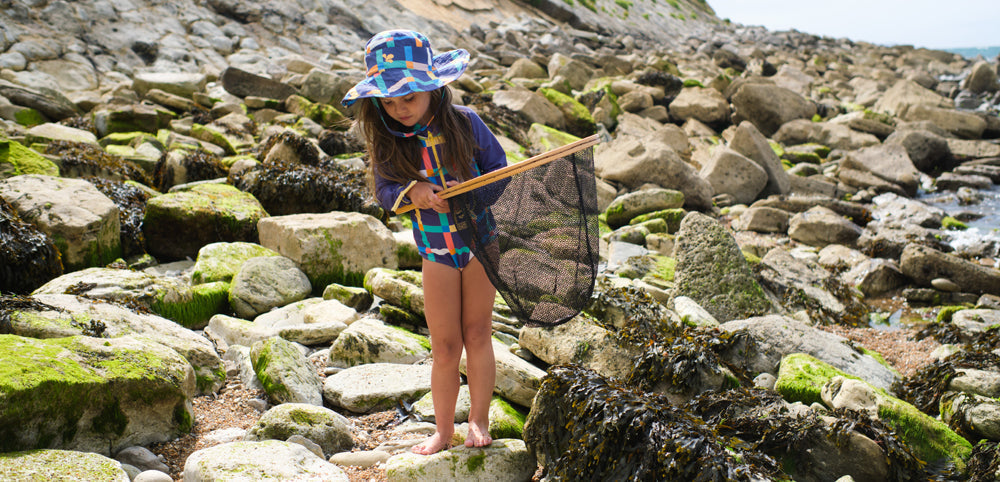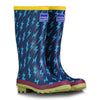
Guide to Rock Pooling with Children
Rock pooling is a brilliant Summer activity and is huge fun for children of all ages. Here in the UK we have a fantastic coastline, with plenty of rocky pools of water and a huge range of wildlife. When the tide is low we get a glimpse into the wonderful creatures that live below the surface of the water.
We’ve put together a guide to rock pooling, from how it works, to what equipment you need, what to look for, and the best beaches to visit in the UK.
How to go rock pooling
- Check when low tide is by using a tide times website (such as tidetimes.org.uk).
- Slowly submerge a bucket or clear Tupperware container into the water and see what’s inside when you pull it out of the water.
- Observe the wildlife in your bucket, take photos or write down your findings, and slowly submerge your bucket again to set the creatures free.
- Try picking up rocks by hand to see if a crab is hiding underneath, and inspect seaweed to see if anything is hiding within it.
What Equipment do you need?
- Bucket or Tupperware
- Sturdy pair of waterproof shoes (our Puddlestomper Wellies are perfect for this)
- UPF50+ Swimwear, sun hat and sun cream
What to look for?
- Common shore crab
- Common limpet
- Bladderwrack Seaweed
- Common starfish
- Beadlet anemone
- Common blenny or shanny
Best Beaches for Rock Pooling
There are some wonderful beaches for rock pooling all over the UK, so you won’t have to travel too far to find the perfect rocky shore to look for some wildlife.
1) Birling Gap, East Sussex
Birling Gap near Eastbourne is only 2 hours from London and is the perfect place for a family day out, with rock pooling, fossil hunting, and a lovely café with baby changing facilities. The rock pools are full of fish, anemones and creepy crawlies when the tide goes out.

2) Sheringham Beach, Norfolk
Sheringham Beach in Norfolk is an incredible sandy beach with an array of rock pools hidden amongst boulders when the tide goes out. It’s perfect for families, because the sand is just right for sandcastles, the rock pools are brilliant for nature lovers, and it’s patrolled by lifeguards for extra peace of mind.
3) St Helen’s Duver, Isle of Wight
St Helen’s Duver on the Isle of Wight is a haven for wildlife, with sandy beaches, rock pools, sand dunes, and coastal woodland, all within a small, easy-to-explore area. When the tide goes out, the rock pools are full with whelks, limpets, periwinkles, sea anemones, worms, crabs and small fish. There is a lovely café with beautiful views and delicious crab sandwiches.
4) Kimmeridge Bay, Dorset
Kimmeridge Bay is near Wareham in Dorset, and is located within a marine special area of conservation, with the best rock pooling in the county. The bay is also a part of the Jurassic Coast and is a great place for fossil hunting. The Wild Seas centre next to the slipway encourages children to explore the bay, ledges and rockpools, and even has a small aquarium.
5) Caswell Bay, South Wales
Caswell Bay near Swansea is a sought after beach which is popular with surfers and families. It has incredible views, a lovely beach café, and is completely wheelchair (and buggy) accessible. The rock pools are filled with wildlife, perfect for a day out with little ones.
6) Porlock Weir, Somerset
Porlock Weir in Somerset has a long pebble and rock beach, making it perfect for rock pooling. The diverse ecosystem means that Porlock Weir is recognised as a site of special scientific interest, so visitors are sure to discover an array of interesting creatures in the huge stretch of rock pools.
7) Saltburn-on-Sea, North Yorkshire
Saltburn-on-Sea is a Victorian seaside resort in North Yorkshire, with a cliff tramway and miniature railway. The beach is a combination of sand and shingle, and is one of the best surfing spots on the north sea coast, with plenty of rocky pools for children to explore.

8) Wembury Beach, Devon
Wembury Beach in Devon is renowned for rock pooling, with Bill Oddie voting it his top spot for rock pooling in the UK. The spectacular stretch of coastline has dramatic cliffs and a huge range of wildlife to discover. At low tide it is easy to spot limpets, anemones, crabs, sea scorpions and sucker fish.
9) Treyarnon Bay, Cornwall
Treyarnon Bay near Padstow in Cornwall is a beautiful sandy beach surrounded by cliffs and backed by sand dunes. The rocky landscape means there are plenty of rock pools to discover at low tide, with shrimps, crabs and small fish.
10) Creswell Beach, Northumberland
Creswell Beach is a long sandy beach just south of Druridge Bay in Northumberland. It is renowned for it’s wildlife and is a great spot for birdwatching, and has a great selection of rock pools which are perfect for looking for sea creatures at low tide. Its high sand dunes are great for offering some protection from the wind, making it a perfect spot for a family day out.










